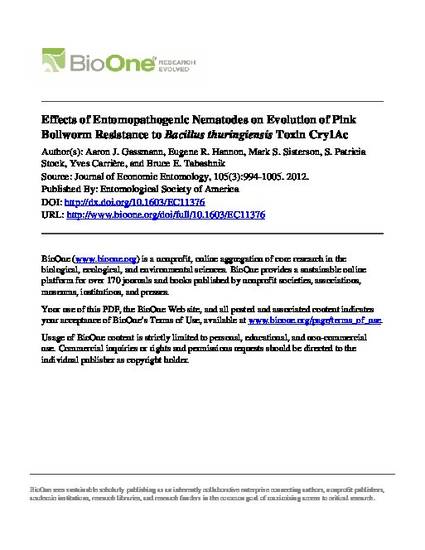
The evolution of resistance by pests can reduce the efficacy of transgenic crops that produce insecticidal toxins from Bacillus thuringiensis (Bt). However, fitness costs may act to delay pest resistance to Bt toxins. Meta-analysis of results from four previous studies revealed that the entomopathogenic nematode Steinernema riobrave (Rhabditida: Steinernematidae) imposed a 20% fitness cost for larvae of pink bollworm, Pectinophora gossypiella (Saunders) (Lepidoptera: Gelechiidae), that were homozygous for resistance to Bt toxin Cry1Ac, but no significant fitness cost was detected for heterozygotes. We conducted greenhouse and laboratory selection experiments to determine whether S. riobrave would delay the evolution of pink bollworm resistance to Cry1Ac. We mimicked the high dose/refuge scenario in the greenhouse with Bt cotton (Gossypium hirsutum L.) plants and refuges of non-Bt cotton plants, and in the laboratory with diet containing Cry1Ac and refuges of untreated diet. In both experiments, half of the replicates were exposed to S. riobrave and half were not. In the greenhouse, S. riobrave did not delay resistance. In the laboratory, S. riobrave delayed resistance after two generations but not after four generations. Simulation modeling showed that an initial resistance allele frequency >0.015 and population bottlenecks can diminish or eliminate the resistance-delaying effects of fitness costs. We hypothesize that these factors may have reduced the resistance-delaying effects of S. riobrave in the selection experiments. The experimental and modeling results suggest that entomopathogenic nematodes could slow the evolution of pest resistance to Bt crops, but only under some conditions.
Available at: http://works.bepress.com/aaron_gassmann/33/

This article is from Journal of Economic Entomology, 105 (2012): 994, doi:10.1603/EC11376.